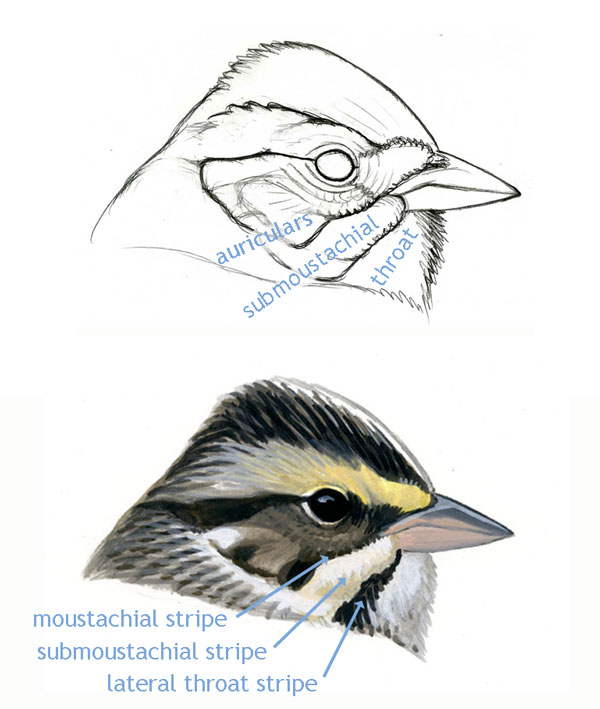The feathers along the side of the lower jaw have a very confusing history of terminology. They’ve been called the malar stripe (in many early and mid 20th century bird books), the submoustachial ((Because this was a British proposal, the spelling is British “moustache” rather than the American “mustache”, and American bird guides have continued to use that spelling)) stripe (in most bird guides published in the 1980s and later), and the malar again (in my Sibley Guide to Birds).

The trouble really started in 1981 when – in an effort to standardize feather descriptions – “submoustachial stripe” was introduced and the term “malar stripe” was shifted down to describe a dark stripe on the side of the throat. That was wrong, so in 2000 I proposed the new term “lateral throat stripe”, and reverted to the old use of malar (replacing the new “submoustachial”).
All of that proved too confusing, and while “lateral throat stripe” has been adopted by many, the term malar has continued to have two meanings ((e.g. the newest edition of the National Geographic field guide still calls the dark stripe on the side of the throat the “malar stripe”)), neither of which fits its dictionary definition of “related to the cheeks”.
In a recent commentary in British Birds, Keith Vinicombe and Lars Svensson point to all of this confusion and suggest simply retiring the term “malar”, and I agree completely. They go on to endorse the term “lateral throat stripe” and further suggest that, for the feathers on the side of the lower jaw, the best term is the already established “submoustachial”.
After long consideration, I agree. My only hesitation comes from my personal bias against the word submoustachial. It seems unnecessarily complex and dependent, like describing our jaw-line as “below the moustache”. It’s a significant and always-recognizable feature. Why is it named with a reference to something less constant? I would like to see a new term like “jaw stripe” used for these feathers along the side of the lower jaw, but I understand that there really isn’t a pressing need to fix this, and I will accept submoustachial.


Late to the party, but two comments:
1) In most other contexts, “malar” refers to cheek, which makes its use for the lateral throat stripe just way, way too low for me to use comfortably. I like “moustachial stripe” (I guess there’s no controversy about that one) and “lateral throat stripe” just the way you have them on the Savannah Sparrow, and “malar stripe” (though jaw stripe would be fine as well) for what’s labeled “submoustachial stripe” in same.
2) “Submoustachial” is OK, logic & memory wise, but why have to think/say/scribble down a 5 syllable word for a single field character amongst a list of many which you might be trying to note down/commit to memory from a brief sighting? Also, a little too jargony/esoteric sounding to me; seems like it would put off/intimidate beginners.
Thanks for these comments. It is true that “malar” means “related to the cheek”, and applying it this way in birds is a little too low on the side of the head. That’s one reason I like the idea of using a new term like “jaw stripe” or “mandibular stripe”. I agree with your critique of submoustachial, and would add that my biggest concern with it is that there are no “moustachial” feathers. Many birds have a moustachial stripe, which is a dark stripe (usually) or a white stripe (on woodpeckers) that runs along the lower edge of the auriculars. A species like Dark-eyed Junco simply has gray auriculars, without a moustachial stripe, and then gray “submoustachial” feathers below that. “Subauricular feathers” would be better in that case.
Pingback: A little bird anatomy – feather groups of the head | Myr's Bytes